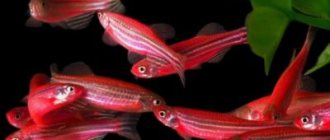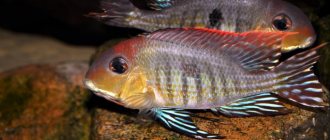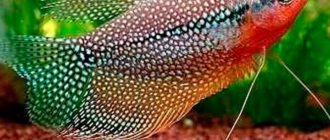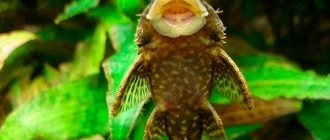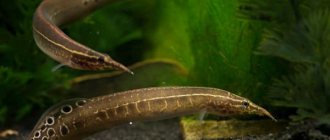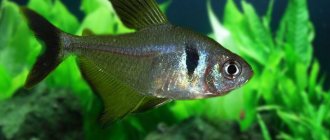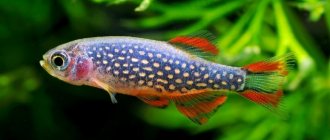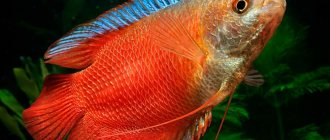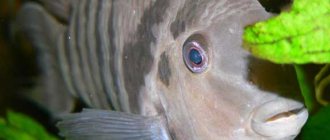Tarakatum is one of the most common catfish in our aquariums. Their popularity is due to their unpretentiousness, endurance and peaceful disposition.
Latin name: Hoplosternum thoracatum.
Correct name: Many call this fish t A rakatum, probably comparing it with a cockroach, but it is still correct to say t O rakatum, from the Latin “thorax” - shell.
Synonyms: Torakatum, hoplosternum, catfish thoractum, tarakatum catfish. Family: Armored catfish. Water temperature: 22-28 C. Ph “acidity”: 5.8-7.5. dH: up to 25. Behavior: Peaceful. Content difficulty: Very easy. Compatibility: Virtually any fish - these catfish - do not pose any threat to other inhabitants of the aquarium.
Incompatible: Tarakatums do not get along with aggressive and predatory fish, such as large cichlids. It is not recommended to keep them with labeos and bots , since the latter chase them, which is explained by the struggle for territory. In addition, it is better not to combine cockroaches with fish that are too small; at some point, the catfish may still eat the small fry.
How long do they live: Tarakatums are long-lived in aquariums and can live more than 10 years. You can find out how long other fish live HERE!
Visualization of the thoracatum sausage
Minimum aquarium volume for cockroach
Torakatum
These are catfish that reach quite large sizes - 18 cm in length or more. Therefore, it is better to keep them in an aquarium of 100 liters or more. for a couple. If the aquarium is smaller, then the catfish simply will not grow and will be “dwarf-sized,” which can lead to illness, stress and death of the fish. Find out how many fish you can keep in X liters of aquarium HERE (at the bottom of the article there are links to aquariums of all sizes).
Tarakatum
Natural habitat: Northern and Central South America and about. Trinidad, river basins Amazons and reservoirs of Guiana. They live in reservoirs with running water, as well as in reservoirs where the water is poorly enriched with oxygen.
Arrangement of the aquarium: It is better to keep Tarakatums in a general aquarium with dense thickets of plants and a large number of shelters (grottoes, snags, stones).
A little history: Appeared in Russia (USSR) in 1971.
Torakatum
Description: The fish has an elongated body, with a slightly hunched back and a flat belly. On the sides there are 2 rows of bone plates. The head is wide and slightly flattened, with two pairs of long whiskers. Fish of the armored catfish family additionally possess intestinal respiration.
Tarakatums are very peaceful, usually staying in the lower layer of water, but sometimes they swim into the middle layers. They become active at dusk.
Feeding thoracatums. aquarium fish - they eat everything they see. Sinking tablets for armored corydos catfish are well suited - Tetra Cory ShrimpWafers.
Diseases
It should be noted that cockroach fish are prone to protozoal diseases and can develop, for example, ichthyophthyriasis. To prevent the fish from getting sick, it is not recommended to lower the water temperature in the aquarium below 24° degrees. If cockroaches are infected with ichthyophthyriasis, it is necessary to begin treatment as soon as possible. Sick fish can be treated in a separate or in a community aquarium. You can cure catfish with the drug bicillin 5. The recommended dosage of the drug bicillin 5 in a general aquarium is 500,000 units per 100 liters, six times, every other day.
In a separate vessel, 1,500,000 units per 10 liters, 30 minutes, six times, every other day. Before adding Bicillin 5 to the aquarium, it is diluted in warm water and gradually poured onto the compressor sprayer. It is believed that bicillin 5 loses its properties in bright light, so it is recommended to shade the aquarium. In order not to burn delicate plant species such as: Hornwort, Cirrus, Cabomba, etc., it is necessary to remove plants from it before adding the drug to the aquarium.
Types of thoracatums
Hoplosternum thoracatum - as a separate representative of armored catfish has no analogues, there is only an albino form - here it is.
However, cockroaches, as a family of armored catfish, also include: Hoplosternum littorale (Beige Hoplosternum) and Hoplosternum magdaienae (Hoplosternum Magdalena), as well as Long-whiskered Dianema - Dianema longibarbis and Dianema urostriata and many others.
in the photo Beige cockroach - Hoplosternum littorale
in the photo Hoplosternum Magdalena - Hoplosternum magdaienae
in the photo Long-moustached dianema - Dianema longibarbis
Dianema urostriata
Compatibility with other fish
Tarakatums are peaceful and easy-going fish. But there are two basic rules for selecting neighbors. Firstly, the fish must be proportionate to the catfish, because even a peaceful catfish, if it is very hungry, can eat a small fish. This does not indicate aggression, and such behavior is the exception. And secondly, you cannot house catfish and predatory fish together. For example, cichlids become undesirable neighbors. A large predatory fish will bully a sleepy cockroach. The conflict can turn into a real battle, the consequences of which will be injuries on both sides. Smaller but aggressive fish (for example, labeo) can also bully catfish: a struggle for territorial leadership may begin between the males of the two species.
The catfish will not cause any trouble for calm and large fish - it is friendly and patient, and during the day it almost always hides, allowing others to move freely
Females of the same species become ideal neighbors for cockroaches - their personalities and daily routine will coincide, and there will be no reasons for conflicts. In addition, it is easier to keep fish of the same species.
Character trait
Quite often in jokes and ironic statements we hear the phrase “memory like a fish.” This means that the fish is not able to remember. Even if the owner changes every day, she will not notice it. But a catfish is an exception to the rule, especially if it has lived with one owner all its life.
In the evening he swims up to the glass and looks. He begins to fidget, move his mustache, as if he is sniffing through glass. It can suddenly float up, take a breath of air, return to its place, and looking at me, exhale this bubble.
Andrey Tikhomirov, former owner of Tarakatum. Nizhny Novgorod
Video: playful cockroach and his neighbors
The photo shows a female Thorakatum
The most difficult thing in breeding cockroaches is selecting producers. They reproduce in pairs. Pairs are formed independently, but taking into account their tastes and preferences. Therefore, it is best to keep cockroaches in a flock, from which breeding pairs can easily form on their own.
Sexual maturity of breeders occurs at 8-15 months. In essence, the breeding process consists of the male constructing a foam nest, similar to the nest of labyrinth fish, laying eggs and then protecting the clutch.
Adviсe
Despite the fact that the fish are nocturnal, they are able to become strongly attached to the owner and become almost tame, attracting the attention of the aquarist even during the day.
Do not be fooled by the inactive lying of cockroaches on the ground; as for food, they are quite agile. They will always have time to eat with the other inhabitants of the aquarium, and then will spend the whole day collecting leftover food from the bottom. If you do not remove leftover food in time, the catfish can become obese.
Since cockroaches love to hide and are able to crawl into almost any crack, and they grow quite quickly, you need to be very careful when buying artificial grottoes. Today, a catfish will calmly swim through several holes of different diameters, but in a few days it may get stuck in one of them.
The wisdom of thoracatum spawning
As a spawning aquarium, it is best to use a 100-liter reservoir, which is filled 2/3 with settled water and 1/3 with boiled water. The surface of the water is covered 1/3 with floating plants (can be artificial), and it is under the leaves of these plants that the male will build a nest.
Reviews
Aquarists who have cockroaches in their aquarium speak positively about them. They note calmness and lack of aggression towards other members of the aquarium. Catfish should be the first fish to get, because they are tenacious and unpretentious. They themselves clean the tank of waste and debris. But some are upset that you rarely see them during the day. Most often, these creatures hide in poorly lit places, shelters, and plants.
in the photo there is a nest of thoracatums
Having built the nest, the male begins to chase the female, at the same time, not forgetting to guard the nest, from time to time completing it, or even rebuilding it in another place. Such manipulations can continue for quite a long time. Sometimes the “games” drag on for as long as a week.
At the end of this “performance”, the female, ready for spawning, swims up to the male from the side and, taking milk into her mouth, rises to the nest, turns over with her belly up and begins to glue the eggs to the leaf of the plant. At one time, the female can spawn from 500 to 1200 eggs. The caviar is yellow-white, large. The spawning process lasts a couple of hours. Afterwards the male closes the nest.
The incubation period of eggs is 10 days. In cockroaches, the male guards the clutch and looks after the offspring.
Description
The fish is light brown in color with large dark spots scattered on the fins and body. Dark spots appear in teenagers and remain as they grow older.
The only difference between juveniles and adults is that the light brown color becomes darker over time.
During spawning, the belly of males acquires a bluish tint, but during normal times it is creamy white. Females have a white belly color all the time.
They live quite a long time, life expectancy is 5 years or more.
in the photo there is thoracatum caviar
If necessary, the leaf with eggs can be transferred to another aquarium immediately after spawning, while in the new reservoir weak aeration is installed under the leaf to create a flow of water.
After approximately 7 days, the eggs hatch into viable larvae. Having fallen to the bottom, they immediately begin to look for food.
in the photo is a cockroach larva
Starter food: live dust, finely chopped tubifex, other finely ground dry food.
After a week, the fry reach a length of 1 cm. During this period, it is very important to monitor the quality of the aquarium water - change it daily to ? old water to fresh, settled water.
Tarakatum photo
The most important thing in keeping any fish is that there are no excessive concentrations of nitrogen compounds and phosphates . This is the main problem for fish that beginners make. Ammonia, nitrite, nitrate, phosphates are the root cause of illness and death in pets. Every conscientious aquarist should always have a set of drop tests on hand, at least for nitrate and phosphate. Fortunately, they have now become inexpensive, there are no problems with their assortment and acquisition. For example, we can with a clear conscience recommend you the cool UHE drop tests, , but they are sold only online. In stores in your city - offline, you can find inexpensive Vladox tests .
Tarakatum
When changing water, it would be useful to use clean water supply and use preparations that neutralize harmful substances. For example, Tetra AquaSafe - it removes chlorine compounds, heavy metals + contains B vitamins, iodine and other aquarium goodies.
Those. With it, you can safely pour water into the aquarium without fear of harming your beloved pets.
Feeding
Catfish fish are not picky about food. You can create a complete diet for her from live, frozen or dry food.
Of course, the most preferable would be live food: bloodworms, tubifex, cyclops, chopped earthworm and coretra. Since these are the organisms that cockroaches feed in nature. This diet has its drawbacks. Live food contains various harmful bacteria that can cause illness in fish. To take care of the health of catfish, live food should be thoroughly washed before feeding. The second point is related to the fact that it can be difficult to find a store that sells such food.
Frozen formulas are more accessible and safer. They are prepared from the same microorganisms that fish feed on in their natural habitat, but are pre-treated to kill pathogenic bacteria. Frozen formula should be divided into portions sufficient for one feeding and stored in the refrigerator. Then take out one cube, hold it for 10-15 minutes at room temperature, and then send it to the aquarium.
In conditions where there is nowhere to buy live food, and nowhere to store frozen mixtures, dry food will come to the rescue. They are not inferior in nutritional value to live and frozen ones.
Some aquarists feed cockroaches with beef heart. The film is removed from it, cut into small pieces and frozen. Immediately before feeding, frozen meat is grated and sent to the fish in small portions. You can also feed the catfish with white bread, rinsing it well under the tap so that the water in the tank does not become cloudy.
Important!
Cockroaches are fed once a day in the dark. The duration of feeding is 5 minutes, after which all uneaten food must be removed from the aquarium.
Tarakatum is not capricious in food, but the diet should be varied
Habitat in nature
Tarakatum lives in South America, in the northern part of the Amazon River. They are found on the islands of Trinidad and some have even settled in Florida after being released by careless aquarists.
Color: from light brown to dark coffee, almost black. Darker, irregularly shaped spots are scattered throughout the body and fins. Size: hoplosternum grows up to 20 cm. Weight: up to 350 g. Content level: easy. Life expectancy: up to 5 years.
Feeding: Diet: live, plant and combined feeds. It takes food from the bottom.
Behavior: Character: schooling (at least 4 fish), peaceful, bottom, nocturnal. Water zone: bottom layer of water. Can be kept with: goldfish. Cannot be kept with: small fish, Malawian cichlids.
Breeding fish: Sexual differences: the male is smaller and slimmer than the female, his first hard ray of the pectoral fins is colored red-brown. Puberty: 8-14 months. Breeding season: rainy season. Preparation: decrease the temperature by 1-5'C, and then slowly increase it to 25-27'C, lower the water level, change the water frequently. Spawning aquarium: 60-100 l, dH up to 8′, pH 6.5-7.0, t 22-27'C, the male builds a foam nest under wide plant leaves floating on the surface. Ratio of males and females: 1:2-3. Amount of caviar: up to 500-1000 eggs. Egg incubation period: 3-10 days (depending on temperature). Offspring: 24'C, pH 6.5-7.0, dH up to 2′. The water is slightly tinted with methylene blue. Newborn larvae are 6 mm long. The juveniles swim for 2 days, are afraid of light, and hide in shelters. Feeding of juveniles: brine shrimp, small cut tubifex, green dust, rotifer. Detachment from parents: the male guards the nest, the female is separated. Growth rate: fast.
Maintenance and care
Although the fish can adapt to any living conditions, its health and endurance should not be tested. Organizing the right conditions for your pet will not be difficult, but the catfish will delight you with its activity and good health for a long time.
Aquarium dimensions
Given the large size of adult catfish, the aquarium must be selected in the appropriate size. For one pair you will need a tank with a volume of at least 100 liters. But most often the fish are kept in a small group of 5-6 females and one male. Keeping cockroaches in an aquarium that is too small can result in the following consequences:
- dwarf-sized catfish;
- stress;
- pathologies;
- death of pets.
Important! The container must be closed with a lid. the fact is that catfish can breathe air using their intestines. By swimming to the surface of the water and miscalculating the force of the jump, they can jump out of the aquarium.
Water
Under natural conditions, catfish can survive in water with very different parameters: for example, both fresh and slightly brackish water, moderately polluted (where other species of underwater inhabitants are likely to die), with varying hardness and acidity are suitable for life. Thanks to intestinal respiration, they can live even in oxygen-poor water. However, in a home aquarium it is necessary to create the most comfortable conditions for your pet.
Basic water parameters:
- temperature: 22–28 °C;
- hardness: up to 25 °;
- pH level: 5,8–8;
- purification: to purify water, it is preferable to choose a powerful external rather than an internal filter;
- change: up to 1/2 volume of water should be replaced weekly.
Learn about these types of catfish: striped, corydoras, changeling, otocinclus affinis, plecostomus, brocade, ancistrus.
Lighting
Everything here is extremely simple - cockroaches are bottom-dwellers, therefore bright sunlight is not typical for their natural environment. In a home aquarium, you don’t need to install additional sources of artificial light - daylight is enough for catfish. But to make the aquarium look more picturesque and colorful, you can install several weak lamps.
In order for pets to feel comfortable and safe in this light, it is necessary to equip the tank with a variety of shelters in which the fish will hide during the day.
Soil and plants
The bottom of the tank must be covered with soft soil; you can also use fine gravel or coarse sand. Being bottom dwellers, cockroaches simply love to scurry around and dig through the soil in search of food, without damaging the roots of plants.
The plant material for an aquarium with catfish should be large-leaved - the catfish will be very comfortable resting under the cover of foliage. In the case of cockroaches, the denser the vegetation, the better for the fish.
The following species can be planted in the tank:
- Echinodorus;
- cryptocoryne;
- Anubias;
- Vallisneria.
Scenery
An aquarium with cockroaches necessarily requires a variety of decor. It, together with vegetation, is actively used by catfish for daytime rest. How you can equip the tank:
- large stones;
- ceramic grottoes, caves, shards and pots;
- pieces of shell rock;
- wooden driftwood;
- pipe fragments.
Important! The number of hiding places in the aquarium should be equal to or greater than the number of catfish living in it, so that no one feels left out.
What to feed
Although your pet is not picky about food, some feeding rules will still need to be followed:
- Feeding occurs once a day in the late evening, when the fish becomes active.
- Eating the food should last 5 minutes, then all leftovers (if any) are removed from the aquarium.
- Food should be varied.
The diet of catfish consists of plant products (mainly algae) and animals: bloodworms, earthworms, tubifex, cyclops, coretra, finely chopped meat. But before feeding live food, you should wash it thoroughly and buy only a high-quality product, otherwise live food often becomes the cause of infectious diseases in fish.
A convenient and acceptable option is to purchase branded special food for catfish. It is very interesting to watch a catfish while feeding: at the sight of food, your usually slow, sleepy, clumsy pet becomes overactive and energetic! They can pick up food both at the bottom of the tank and swim to the surface of the water in order to quickly grab the tidbit.
Sexual characteristics
To purchase a pair of catfish for breeding, you will need to identify a male and a female from a variety of fish, so you need to know their differences. This knowledge will also be useful when their fry begin to grow up.
The Tarakatum catfish has well-defined sexual characteristics, so it is easiest to distinguish them:
- Size. Females are slightly larger than male fish.
- Abdomen. During the mating season, the abdominal cavity of pets can change color, but this only applies to males.
- Fins. The female’s fins have a rounded shape, compared with the opposite sex, in which they are longer, brown in color and protrude strongly forward.
Conclusion
This interesting fish deserves the attention of every aquarist.
Good compatibility with other fish, the unusual appearance and interesting behavior of the Tarakatum catfish have served them well. Their popularity does not decrease from year to year, but rather grows. Natural vitality, good adaptation and unpretentiousness in food make caring for the Tarakatum catfish very easy. These fish can be recommended to beginning aquarists.
